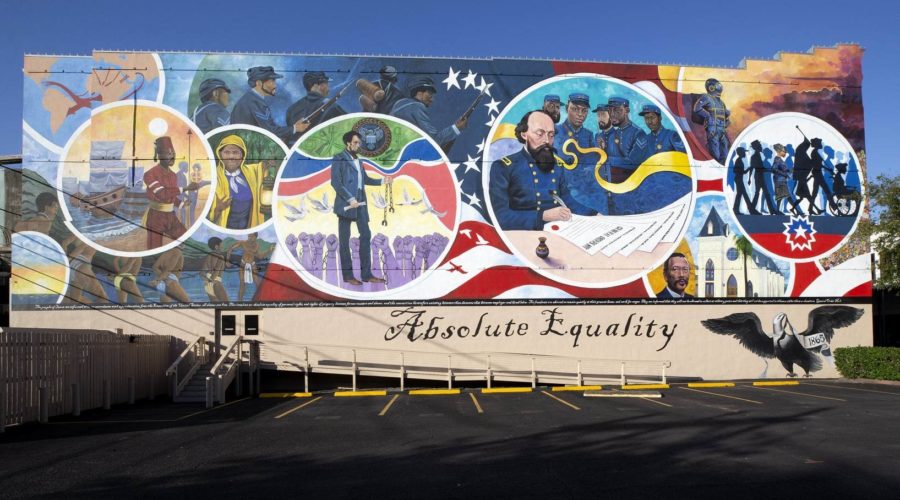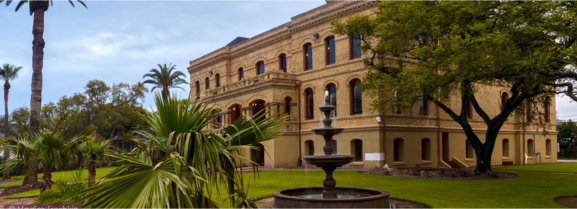Galveston: Birthplace of Juneteenth
The history of the Upper Texas Coast is one of the many things that makes it attractive to visitors and residents. As part of your visit to the region, learn more about Galveston’s history as the birthplace of Juneteenth by stopping by the Absolute Equality Mural on 22nd and Strand. Lone Star Coastal Alliance asked historian and co-founder of the Juneteenth Legacy Project Samuel Collins III to share the history of Juneteenth in Galveston, some little-known facts, and details about this permanent, public art installation.
Absolute Equality Mural, Galveston, Texas
From the Juneteenth Legacy Project
By Samuel Collins III, CTA
Galveston is a city rich in history, with many monumental events and people connected to the island. The Great Storm of 1900 and the story of Galveston’s most famous native son Jack Johnson are two well-known examples, but another date that is important to all of American history also has direct ties to Galveston—June 19, 1865, commonly known as Juneteenth.
This date celebrates the end of enslavement in America, although the official end of American slavery did not happen until the Thirteenth Amendment to the Constitution was ratified in December 1865. President Abraham Lincoln signed the amendment on February 1, 1865, only a couple of months before his assassination in April.
Most importantly, Juneteenth celebrates the evolution of the country to a more perfect union. The United States was not perfect in 1528, 1619, 1776, 1865, nor today, and nothing magical will happen to make it perfect tomorrow. Still, Americans must always continue to work to become a more perfect union.
Juneteenth celebrations have been organized for many years, and the story of Major General Gordon Granger arriving in Galveston to announce the end of slavery has been told many times. Granger’s Union headquarters was located in the Osterman building at 22nd Street and Strand. Sometimes, history mentions that Granger had two thousand Union soldiers with him, but detailed information about those soldiers is scarce.
However, the story actually begins nearly three years prior to Granger’s arrival. President Abraham Lincoln signed the Emancipation Proclamation on September 22, 1862, projected to go into effect January 1, 1863. During the Civil War, Union forces took control of Galveston in the Fall of 1862, but lost the island on January 1, 1863, in the Battle of Galveston.
As a result of the Confederate victory, the enslaved people of Texas were forced to wait another two and a half years before Granger’s arrival and his issuance of General Orders No. 3. Unlike the commonly told story, news of the Emancipation Proclamation was not ‘late’ to Texas. During the war, Southern states did not recognize President Lincoln as their leader and had no plans to enforce the Emancipation Proclamation.
Many believe Lincoln’s Emancipation Proclamation was his first action to free enslaved people, but it was not. The first enslaved person Abraham Lincoln helped to free was a woman named Nance Legins-Costley in 1841. Nance married a freedman Benjamin Costley and bore children, but she and her children were still considered property of her former owner.
In 1841, Abraham Lincoln was still a young attorney, but by helping Legins-Costley win her freedom, he also helped free her children. Her son William Costley was the first enslaved male that Lincoln helped to free. This is a significant piece of history that few people know.
Today, one of the main goals of the National Trust for Historic Preservation is to tell the full story of American history. They are working to expand the narrative of the shared history of the United States, and the Juneteenth story is one of those historical events that only recently has been seen as significant to America’s freedom story.
“We’re confident this Galveston landmark at the genesis of Juneteenth will serve as a special space to reflect and expand our knowledge in a very public place, celebrating freedom, opportunity, and absolute equality for all. For school children, the greater community, and visitors from all over the world.”
Sheridan Lorenz, Co-founder of the Juneteenth Legacy Project
Juneteenth was an important symbolic date to the former enslaved, and it has always been significant to their descendants. Although Black Americans have celebrated Juneteenth since the late 1800s, its emergence on the national, mainstream stage happened in the summer of 2020.
As part of the evolution of these celebrations, and with the support of a 25-member group of Galveston community leaders, activists, and philanthropist Sheridan Lorenz, the Juneteenth Legacy Project was formed. The Nia Cultural Center is the Juneteenth Legacy Project’s fiscal sponsor accepting tax-deductible donations on behalf of the organization.
The first public project for the Juneteenth Legacy Project was a public art mural on the east-facing wall of the Old Galveston Square building located at 2211 Strand, adjacent to the former location of the Osterman building. This massive art installation covers almost 5,000 square feet.
This public art project, created by Houston artist Reginald C. Adams, is nationally significant for many reasons. As the work of reimagining monuments and memorials in public spaces begins, this mural is an example to the rest of the nation.
The mural includes an augmented reality segment that allows visitors to learn the history of the images in the mural. Visitors to the historic site where the Osterman building once stood can point their smartphones at the mural and use an app to learn the history.
The art installation’s title, “Absolute Equality” was taken from Major General Gordon Granger’s General Orders No. 3 issued on June 19, 1865. It reads in part, “The people of Texas are informed that, in accordance with a proclamation from the Executive of the United States, all slaves are free. This involves an absolute equality of personal rights and rights of property between former masters and slaves…”
Formerly enslaved people of Texas believed that freedom and absolute equality had finally arrived with the pronouncement of these words. However, area attorney Fay Williams tells the story her grandfather told her. Williams recounts, “It was not a piece a paper that freed the enslaved people of Texas, but the men with the guns.”
The men with guns to which her grandfather was referring were the United States Colored Troops that arrived in Galveston as Union soldiers and Texas before Granger. The Civil War ended on April 9, 1865, when Confederate General Robert E. Lee surrendered in Virginia. Many white soldiers were mustered out shortly thereafter and return home to their families. Thousands of Union colored troops were sent to Texas along with other white Union soldiers.
The colored troops have often been left out of the Juneteenth narrative and not celebrated for their contributions to the Civil War or their involvement in spreading the message of freedom throughout Texas. By January of 1866, seventy-five percent of Union soldiers in Texas were United States Colored Troops. There were 6,500 white soldiers and 19,768 black soldiers.
This public art project highlights those soldiers along with President Lincoln and Major General Granger. It took all of them working together to bring the message of freedom to Texas.
Interestingly, the first enslaved male who Lincoln freed, Nance’s son William grew up and joined the Union Army during the Civil War. William was part of the 29th Illinois Regiment of United States Colored Troops that was sent to Texas in June 1865. He was in Galveston in June 1865 to enforce law and order.
As co-founder of the Juneteenth Legacy Project Sheridan Lorenz has said, “We’re confident this Galveston landmark at the genesis of Juneteenth will serve as a special space to reflect and expand our knowledge in a very public place, celebrating freedom, opportunity, and absolute equality for all. For school children, the greater community, and visitors from all over the world.”
The Juneteenth Legacy Project Mural and Storytelling Space is a recommended stop in the Texas History Trip Plan
For more ideas for exploring the Upper Texas Coast, click Things to Do, search by category, and check the Trip Plans for suggested stops.
About Lone Star Coastal Alliance
The Lone Star Coastal Alliance is a 501(c)3 created to preserve and promote the upper Texas Gulf Coast region in a manner that enhances coastal resilience while fostering economic development focused on conservation and tourism, elevating the unique natural, cultural, and historical assets of the region and benefitting quality of life within the communities.



